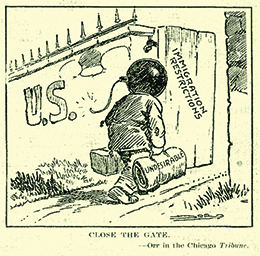| << Chapter < Page | Chapter >> Page > |
Private citizens who considered themselves upstanding and loyal Americans, joined by discharged soldiers and sailors, raided radical meeting houses in many major cities, attacking any alleged radicals they found inside. By November 1919, Palmer’s new assistant in charge of the Bureau of Investigation, J. Edgar Hoover, organized nationwide raids on radical headquarters in twelve cities around the country. Subsequent “Palmer raids” resulted in the arrests of four thousand alleged American radicals who were detained for weeks in overcrowded cells. Almost 250 of those arrested were subsequently deported on board a ship dubbed “the Soviet Ark” ( [link] ).

By 1920, Americans had failed their great expectations to make the world safer and more democratic. The flu epidemic had demonstrated the limits of science and technology in making Americans less vulnerable. The Red Scare signified Americans’ fear of revolutionary politics and the persistence of violent capital-labor conflicts. And race riots made it clear that the nation was no closer to peaceful race relations either. After a long era of Progressive initiatives and new government agencies, followed by a costly war that did not end in a better world, most of the public sought to focus on economic progress and success in their private lives instead. As the presidential election of 1920 unfolded, the extent of just how tired Americans were of an interventionist government—whether in terms of Progressive reform or international involvement—became exceedingly clear. Republicans, anxious to return to the White House after eight years of Wilson idealism, capitalized on this growing American sentiment to find the candidate who would promise a return to normalcy.
The Republicans found their man in Senator Warren G. Harding from Ohio. Although not the most energetic candidate for the White House, Harding offered what party handlers desired—a candidate around whom they could mold their policies of low taxes, immigration restriction, and noninterference in world affairs. He also provided Americans with what they desired: a candidate who could look and act presidential, and yet leave them alone to live their lives as they wished.
Learn more about President Harding’s campaign promise of a return to normalcy by listening to an audio recording or reading the text of his promise.
Democratic leaders realized they had little chance at victory. Wilson remained adamant that the election be a referendum over his League of Nations, yet after his stroke, he was in no physical condition to run for a third term. Political in-fighting among his cabinet, most notably between A. Mitchell Palmer and William McAdoo, threatened to split the party convention until a compromise candidate could be found in Ohio governor James Cox. Cox chose, for his vice presidential running mate, the young Assistant Secretary of the Navy, Franklin Delano Roosevelt.
At a time when Americans wanted prosperity and normalcy, rather than continued interference in their lives, Harding won in an overwhelming landslide, with 404 votes to 127 in the Electoral College, and 60 percent of the popular vote. With the war, the flu epidemic, the Red Scare, and other issues behind them, American looked forward to Harding’s inauguration in 1921, and to an era of personal freedoms and hedonism that would come to be known as the Jazz Age.
The end of a successful war did not bring the kind of celebration the country craved or anticipated. The flu pandemic, economic troubles, and racial and ideological tensions combined to make the immediate postwar experience in the United States one of anxiety and discontent. As the 1920 presidential election neared, Americans made it clear that they were seeking a break from the harsh realities that the country had been forced to face through the previous years of Progressive mandates and war. By voting in President Warren G. Harding in a landslide election, Americans indicated their desire for a government that would leave them alone, keep taxes low, and limit social Progressivism and international intervention.

Notification Switch
Would you like to follow the 'U.s. history' conversation and receive update notifications?